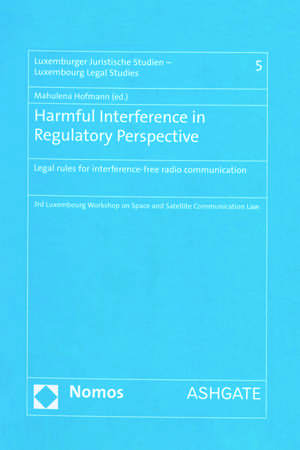Harmful Interference in Regulatory Perspective: Legal rules for interference-free radio communication
Autor Mahulena Hofmannen Limba Engleză Hardback – 11 feb 2016
Preț: 764.62 lei
Preț vechi: 1103.04 lei
-31% Nou
Puncte Express: 1147
Preț estimativ în valută:
146.36€ • 159.03$ • 123.02£
146.36€ • 159.03$ • 123.02£
Comandă specială
Livrare economică 31 martie-14 aprilie
Doresc să fiu notificat când acest titlu va fi disponibil:
Se trimite...
Preluare comenzi: 021 569.72.76
Specificații
ISBN-13: 9781472473806
ISBN-10: 1472473809
Pagini: 288
Dimensiuni: 156 x 234 mm
Greutate: 0.48 kg
Ediția:1
Editura: Taylor & Francis
Colecția Routledge
Locul publicării:Oxford, United Kingdom
ISBN-10: 1472473809
Pagini: 288
Dimensiuni: 156 x 234 mm
Greutate: 0.48 kg
Ediția:1
Editura: Taylor & Francis
Colecția Routledge
Locul publicării:Oxford, United Kingdom
Notă biografică
Professor Mahulena Hofmann, SES Chair in Space Communication and Media Law at the University of Luxembourg. Prior to her appointment at the University of Luxembourg, Professor Hofmann was the holder of the Jean Monnet Chair in European Law and Transition Studies at the Faculty of Law, Justus Liebig University of Giessen. At the same time she served as a Senior Research Fellow at the renowned Max Planck Institute for Comparative Public Law and International Law where her research activities were in the field of International Space and Telecommunications Law, as well as the public law of Central and Eastern European countries. Member of the European Centre for Space Law and an Expert Committee of the Council of Europe dealing with regional and minority languages, she has a rich scientific profile encompassing all aspects of Satellite Communication and Media Law.
Cuprins
Introduction, Mahulena Hofmann. Part I Harmful Interference in the Context of the ITU Framework: 'Harmful interference' and the ITU, Francis Lyall; ITU and harmful interference prevention, Mitsuhiro Sakamoto; Dealing with harmful interference: the Protostar case, Elina Morozova and Yaroslav Vasyanin; Radio frequency interference in the Earth Exploration Satellite Service: the case of the European Space Agency's SMOS mission, Alexander Soucek; Contractual responses to loss of satellite based services, Lesley Jane Smith. Part II Harmful Interference in the Context of Space Law: The 'space side' to 'harmful interference' - evaluating regulatory instruments in addressing interference issues in the context of satellite communications, Frans von der Dunk; Harmful interference in telecommunications under international and national space law, Jean-Francois Mayence. Part III Harmful Interference in the Context of European Law: European law as an instrument for avoiding harmful interference, Gerry Oberst; The European Commission's proposal for a 'connected continent', Max Spielmann. Part IV Harmful Interference from the Perspective of National Law: Harmful interference from the Netherlands Radiocommunication Agency perspective, Johan Kroon; Satellite harmful interference: a U.S. Telecom perspective, Justin (Gus) Hurwitz. Part V Other Instruments for Avoiding Harmful Interference: New and alternative means for safeguarding the efficient use of spectrum resources for satellite communications, Simona Spassova; Harmful interference and human rights, Olga Batura. Part VI Outstanding Issues: The restructuring of an intergovernmental satellite communications organisation from a Luxmbourg perspective, Guy Modert.
Descriere
This collection analyses the regulatory aspects of harmful interference faced by those entities operating space communication and broadcasting. While technology reacts to this international phenomenon with the development of continuously improving technological systems for preventing and combating harmful interference, its international regulatory and legal framework develops at a much slower pace. The contributors include experts drawn from international and national academia, the ITU, national regulatory authorities and operators to present an international, multidimensional and critical analysis of this complex phenomenon.
